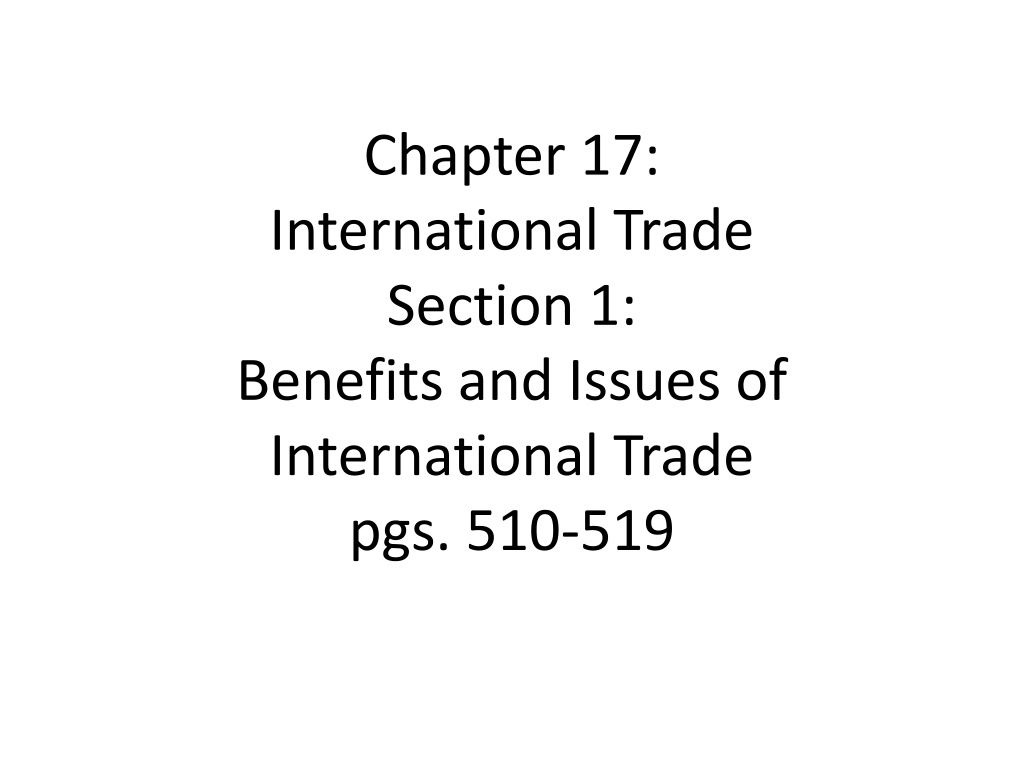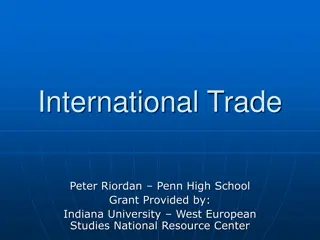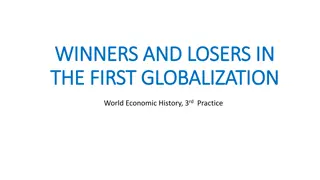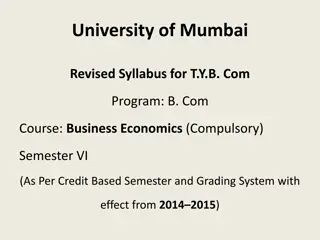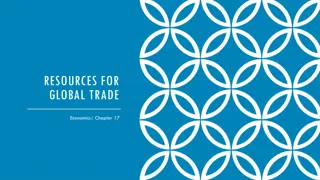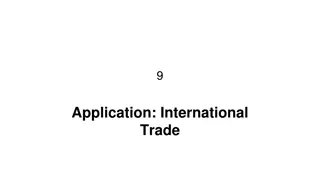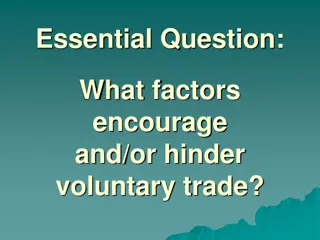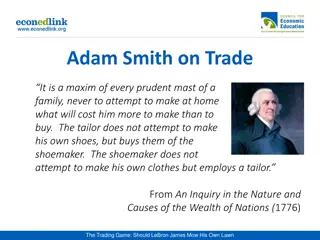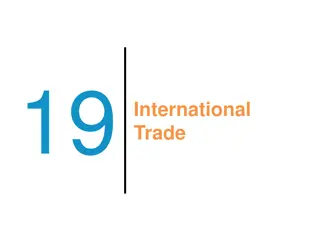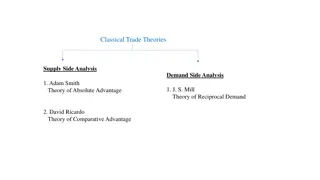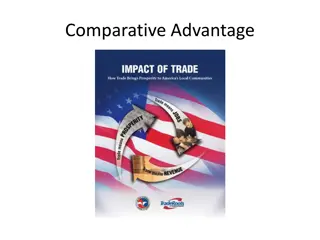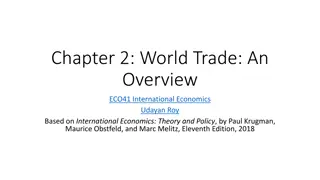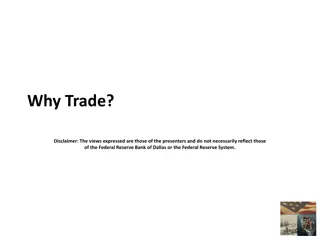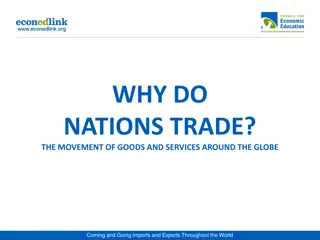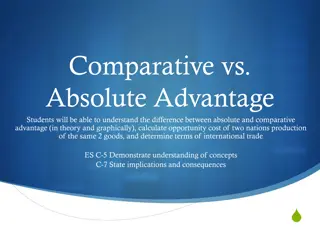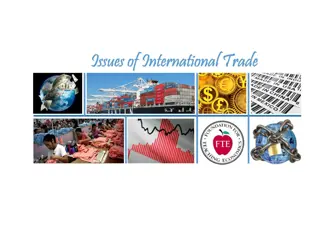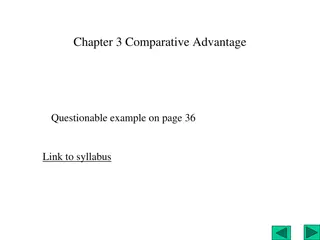Understanding International Trade: Benefits, Specialization, and Comparative Advantage
International trade involves benefits and issues, with specialization playing a key role in driving economic patterns through resource distribution. David Ricardo's theory of comparative advantage revolutionized trade by focusing on producing goods efficiently. Absolute advantage and comparative advantage are crucial concepts in international trade, determining a nation's specialization and efficiency in production.
Download Presentation

Please find below an Image/Link to download the presentation.
The content on the website is provided AS IS for your information and personal use only. It may not be sold, licensed, or shared on other websites without obtaining consent from the author. Download presentation by click this link. If you encounter any issues during the download, it is possible that the publisher has removed the file from their server.
E N D
Presentation Transcript
Chapter 17: International Trade Section 1: Benefits and Issues of International Trade pgs. 510-519
Resource Distribution & Specialization http://fergusonvalues.com/wp-content/uploads/2013/03/Specialization-in-Leadership.jpg A nation s economic patterns are based on its unique combination of factors of production: natural resources, human capital, physical capital, and entrepreneurship. B/c each nation has certain resources and cannot produce everything it wants, individuals & businesses must decide what goods & services to focus on. The result is specialization, a situation that occurs when businesses produce a narrow range of products. Through this, businesses can increase profit the driving force of world trade. Specialization also leads to economic interdependence, a situation in which producers in one nation depend on others to provide goods and services they don t produce.
David Ricardo: The Theory of Comparative Advantage http://www.relatably.com/q/img/david-ricardo-quotes/david-ricardo-5.jpg Ricardo (1772-1823) was not an academic, he was a stockbroker. He earned over $100 million in today s dollars. Ricardo became interested in economics when he read Adam Smith s The Wealth of Nations in 1799. His greatest contribution to economies was an idea that became the backbone of free trade comparative economics. He asserted that a trading nation should produce a certain product if it can do so at an opportunity cost lower than that of another trading nation.
Trading in Opportunity http://ecolan.sbs.ohio-state.edu/Aly/classes/powerpoint/ch2/sld003.jpg Before Ricardo s influence, the prevailing view on international trade was based on the idea of absolute advantage, the ability of one nation to make a product more efficiently than another. Ricardo changed this understanding to be known as the law of comparative advantage: countries gain when they produce items they are most efficient at producing and that have the lowest opportunity cost.
Absolute Advantage Absolute advantage is the ability of one trading nation to make a product more efficiently than another trading nation. Some regions of nations have absolute advantage in producing certain products or services b/c or the uneven distribution of production factors. If a nation can make more iron ore and steel than another nation, then that country has an absolute advantage. https://geeksmagic.files.wordpress.com/2015/07/absolute-advantage.jpg
Comparative Advantage Comparative advantage, in contrast, is the idea that a nation will specialize in what it can produce at a lower cost than any other nation. When determining comparative advantage, you look not for the absolute cost of a product, but for its opportunity cost. Lets say that Australia s opportunity cost for one ton of steel is five tons of iron ore. But China s opportunity cost for one ton of steel is 3 tons of iron ore. T/f China has the comparative advantage. This is the law of comparative advantage: countries gain when they produce items that they are most efficient at producing and are at the lowest opportunity cost. http://study.com/cimages/videopreview/videopreview-small/comparative-advantage-2_102090.jpg
Advantages of Free Trade http://www.intelligenteconomist.com/wp-content/uploads/2014/10/shipping_and_trade_rdax_4256x2848.jpg If China and Australia decide to specialize and trade, they can improve their ratio of return. Previously, China s steel production was 1:3 & Australia s was 1:5. If the two nations establish a trade ratio of 1:4, both nations win. When countries specialize and trade, they not only improve their production ratios but they also increase world output. If China specializes in steel & Australia in iron ore, each can make more of their products than the two nations could have made together if they had not specialized. Increased output is a mark of economic growth, which is a factor in raising standards of living.
International Trade Affects the National Economy http://research-methodology.net/wp-content/uploads/2014/09/Objections-to-Free-Trade1.jpg Because of the law of comparative advantage, nations gain through trading goods and services. Goods and services produced in one country and sold to other country are called exports. Goods and services produced in one country and purchased by another are called imports. The cost and benefits of international trade vary by nation. To understand how trade affects a nation s economy, economists use supply and demand analysis. They look at the impact of exports and imports on prices and quantity.
Impact of Exports on Prices & Quantity Suppose the made-up nation of Plecona didn t trade with other nations. What would happed to prices and demand if Plecona decided to become a trading nations and export its motorbikes? In some nations, like Nepocal, people would began to buy Plecona s bikes. This results in an increase in demand for Plecona s bikes, shifting the demand curve to the right and establishing a new equilibrium price. Bikes will now cost more in Plecona too. H/e, the greater demand resulting from exporting offsets this by creating more jobs and more income in Plecona, as the bike producer invests its profits to expand production and hire more workers. http://timesofindia.indiatimes.com/thumb/msid-45078538,width-400,resizemode-4/45078538.jpg
Impact of Imports on Prices & Quantity Now suppose that Nepocal and Plecona agree that Nepocal may sell cars to Plecona. Instead of only having Plecona s cars, consumers in Plecona may now purchase cars imported from Nepocal. This change adds to the number of car producers in Plecona s market. Adding producers shifts the supply curve of cars to the right and thereby establishes a new, lower equilibrium price. So there are more cars on the market and consumers are paying a lower price for them. Competition also establishes incentives for domestic producers to become more efficient in production, improve worker productivity, and enhance customer service. Consumers benefit b/c there is more selection & better prices and producers benefit b/c they gain new markets & a chance for more profit. https://hiski.tech/wp-content/uploads/2016/01/imported.gif
Trade Affects Employment https://s3-ap-southeast-2.amazonaws.com/tgc-aus/articleImages/AustralianFlag.jpg As nations specialize in their changing areas of strength, the availability of certain jobs can undergo dramatic changes. For example, if Australia specializes in producing iron ore or providing educational services (another area of strength for that nation) at the expense of making steel, then some Australian steelworkers may lose their jobs. At the same time, h/e, the overall number of Australian jobs may increase significantly. The Australian Trade Commission estimates that a 10% increase in exports results in 70,000 new jobs for workers in Australia.
The United States in the World Economy http://www.chebucto.ns.ca/Culture/Shifting_Boundaries/Images/Map/north-america.gif The U.S. is a leading nation in a number of aspects of the world economy. It is the largest exporter in the world, exporting mostly capital goods. (computers, machinery, civilian aircraft, etc.) The U.S. is also the world s largest importer, buying nearly 1.7 trillion worth of goods and services all over the world. We mainly import crude oil and refined petroleum products, machinery autos, consumer goods, and raw materials. The U.S. imports more goods than it exports, but we export more services than we import. The four most important trading partners are Canada (20%), China (12%), Mexico (11%), and Japan (7%). In recent years, we have imported an increasingly larger amount than we have exported. https://s-media-cache-ak0.pinimg.com/736x/c1/42/60/c1426019e2c976de4e3c2a542ec644f3.jpg
